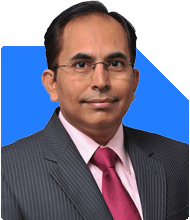50-Year-Old Seeking Retirement Income: Lump Sum or SWP?
Janak Patel |23 Answers |Ask -Follow
MF, PF Expert - Answered on Dec 10, 2024
He is the CEO and founder of InfiniumWealth, a firm that specialises in designing goal-specific financial plans tailored to help clients achieve their life goals.
Janak holds an MBA degree in finance from the Welingkar Institute of Management Development and Research, Mumbai, and has over 15 years of experience in the field of personal finance. ... more

I am 50 years old. For post retirement monthly income I am planning to to park 1 crore lumpsum to avail monthly SWP later. Should I park this lumpsum in one or divide 50 K each in two or three and more and then keep withdrawing 0.5 % from each as swp. Which will be a better option?
Retirement Corpus needs safety and liquidity along with growth as it has to last a long time.
As your complete requirement is not very clear I will mention some numbers to give you an idea and you can plan based on your actual requirement.
Lets say your monthly expense requirement in 50000 per month i.e. 6 lacs per year. This is an amount for the first year, but with Inflation, it will increase each year.
Depending on your risk profile, the Retirement Corpus needs to be invested after prioritizing the 3 parameters - safety, liquidity and growth.
If you have a low risk profile then invest in safe investments - either Debt funds or Fixed deposits - Risk is Inflation will eventually start reducing your corpus.
If you can handle moderate risk then divide the corpus e.g. Keep 75% in growth (with some safety) funds like the Balanced Advantage/Hybrid funds and rest 25% in safe investment such as Debt funds or Fixed deposits from which you can withdraw for monthly expenses.
In your case 25 lacs in safe investment will help manage approximately 4 years of expenses.
The remaining 75 lacs invested in Balanced Advantage funds will continue to provide growth. So if we assume it grows at 8% every year, plan to withdraw 5~8% of your fund and move it into safe investments.
This way you can plan to have approximately 4 years of expenses in safe investments and give the remaining corpus an opportunity to grow to management and stay ahead of inflation.
The above is just a simple view of looking at the Retirement corpus and managing your expenses, but beyond this there are many other aspects that needs to be considered also, such as your health related requirements, your lifestyle requirements, additional goals/responsibilities towards family and life expectancy as you plan for retirement. This will provide you a more accurate and realistic insight into the retirement plan.
Advice you to approach a Certified Financial Planner to provide a comprehensive and customized guidance/plan to you.
Thanks & Regards
Janak Patel
Certified Financial Planner.
You may like to see similar questions and answers below
Ramalingam Kalirajan |8176 Answers |Ask -Follow
Mutual Funds, Financial Planning Expert - Answered on May 12, 2024
Ramalingam Kalirajan |8176 Answers |Ask -Follow
Mutual Funds, Financial Planning Expert - Answered on Sep 04, 2024
Moneywize |181 Answers |Ask -Follow
Financial Planner - Answered on Aug 22, 2024
Ramalingam Kalirajan |8176 Answers |Ask -Follow
Mutual Funds, Financial Planning Expert - Answered on Mar 13, 2025
Rajesh Kumar Singh |276 Answers |Ask -Follow
IIT-JEE, GATE Expert - Answered on Apr 02, 2025
Rajesh Kumar Singh |276 Answers |Ask -Follow
IIT-JEE, GATE Expert - Answered on Apr 02, 2025
Rajesh Kumar Singh |276 Answers |Ask -Follow
IIT-JEE, GATE Expert - Answered on Apr 02, 2025
Dr Dipankar Dutta |1075 Answers |Ask -Follow
Tech Careers and Skill Development Expert - Answered on Apr 02, 2025
Dr Dipankar Dutta |1075 Answers |Ask -Follow
Tech Careers and Skill Development Expert - Answered on Apr 02, 2025
Dr Dipankar Dutta |1075 Answers |Ask -Follow
Tech Careers and Skill Development Expert - Answered on Apr 02, 2025
Milind Vadjikar |1147 Answers |Ask -Follow
Insurance, Stocks, MF, PF Expert - Answered on Apr 02, 2025
Milind Vadjikar |1147 Answers |Ask -Follow
Insurance, Stocks, MF, PF Expert - Answered on Apr 02, 2025
Milind Vadjikar |1147 Answers |Ask -Follow
Insurance, Stocks, MF, PF Expert - Answered on Apr 02, 2025
Ramalingam Kalirajan |8176 Answers |Ask -Follow
Mutual Funds, Financial Planning Expert - Answered on Apr 02, 2025

























